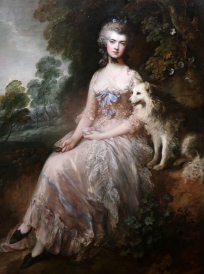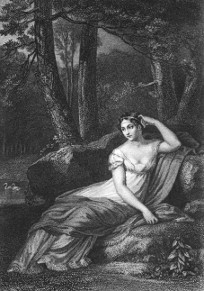

A global archive of independent reviews of everything happening from the beginning of the millennium
For
publication dates click here
Read our Copyright Notice click here
 Thomas Gainsborough, Mrs Robinson
(Perdita)
Thomas Gainsborough, Mrs Robinson
(Perdita)
 Empress Josephine
Empress Josephine
FASHION AND REVOLUTION : DRESS IN THE WORK OF GOYA AND HIS CONTEMPORARIES
A lecture given by Dr. Aileen Ribeiro at New Hall College, Cambridge on 22 November 2000.
Reviewed by ANDRE BEAUMONT
This excellent lecture, given by invitation, by Dr. Ribeiro of the Courtauld Institute will doubtless one day lead to a scholarly publication (for French fashion see Dr. Ribeiro's Fashion in the French Revolution, 1988) well worth reviewing in the Books pages.
Meanwhile, this review can merely give a summary of some of the ideas about late 18th century fashion in Spain that she shared with her audience.
In late 18th century Europe, France and England were the two contenders for Empire. The spread of ideas across borders was also accelerated by the tumultuous events of the French Revolution.
The formality of French dress could be contrasted with the relative informality of English dress, as worn by both men and women.
Until the Revolution, Bourbons sat on both the French and Spanish thrones.
This did not prevent both English and French fashion styles contesting for influence in Spain where they were given characteristically Spanish touches.
Marie-Antoinette was particularly fashion conscious and many French modistes came to Spain where they produced many rather formal garments, for example, Polonaise dresses.
Goya was clearly influenced by Gainsborough, especially in the way he let light play on fabric.
In Goya's work the beauty of the fabrics frequently come across.
Comparing a portrait of Queen Maria Louisa with one by Gainsborough of Queen Charlotte, Dr. Ribeiro highlighted that although Gainsborough's portrait is probably more successful, Goya picks out exquisitely the gold and silver lace on the Spanish queen's dress - this use of lace being characteristic of Spanish dress but not of the less decorated English styles that became influential in Spain in the 1780's.
That decade produced fashion Anglo-mania in both France and Spain, resulting in dresses à la anglaise, like chemise dresses.
Goya, in turn, seemed to have been influenced by the informal Gainsborough family groups, showing the intimacy of family.
In this period, the importance of white for women's dresses was apparent.
Cotton was imported from India. Spanish women prefered to buy English muslin as a superior product to material of local manufacture, or, sometimes, Bengal muslin, which to this day remains the world's finest.
A typically Spanish type of haute couture for women was semi-transparent muslin worn over opaque silk.
The English country style of dress for men, more informal and less embroidered, was adopted by French Revolutionaries and their sympathisers as more progressive.
By the 1790's, the French army had occupied parts of Spain.
Goya's portrait of the French ambassador, shows the painter liberated from the formality of Spanish court dress, in depicting a male sitter.
In this decade, Spain had lost control of its destiny. Women could demonstrate sympathy for England or France, or both, in what they wore. Fashion did not hesitate to draw from both springs.
One Goya portrait of the Duchess of Alba depicts a composite of Anglo-French fashions, given a Spanish twist by the subject wearing a red sash and red bow in her hair.
In another portrait, she wears red ribbon on a white dress.
In France, red ribbon on white was frequently used to signify the cuts made by the guillotine. Whether the Duchess of Alba was aware of this sinister symbolism is unknown.
Both classical and contemporary references could be mixed. A contemporary portrait of the Empress Josephine at Malmaison shows her dressed classically but looking informally relaxed.
Goya's portrait of the Marquesa de Santa-Cruz has similarities.
By the end of the 1790's, Neoclassical dress styles were becoming popular. Dresses à la greque were modish.
A simple muslin dress might be covered with a cashmere shawl, except that in Spain the shawl might be of silk.
Non-elite fashion influences were also absorbed into upper class fashion in late 1790's Spain. This, to some extent, allowed Spanishness to be emphasised.
The use of black for women's dresses could be perceived as being a Spanish trait and Gros and Ingrès may have been influenced by Goya in some of their portraits.
Goya cannot be seen as an ideological painter. He became first court painter in 1799. He can sometimes be perceived as a little mocking of, or sharp to, his subjects but not political. In a court context, he can be seen as quite truthful in his portrayal, not obsequious.
His range is large. His portrait of a friend's wife, Senora Sorreda, sitting on a French Neoclassical chair, is one of his best informal paintings.
A conclusion that might be drawn from the period is that women's fashion is too independent to be a reflection of ideology for long.
Fashion, as used by women, is often an alternative to politics, a different way of playing a game, in, ultimately, a less serious and internecine way than politics.
Yet I am sure the statement can be very powerful. In contemporary times, how often did we see the Princess of Wales push politics, or her perceived adversaries, off the front page by a fashion statement?